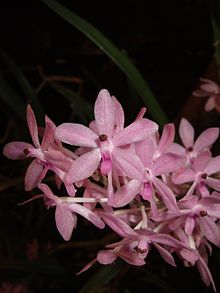
Orchidaceae, commonly called the orchid family, is a diverse and widespread family of flowering plants, with blooms that are often colourful and fragrant.
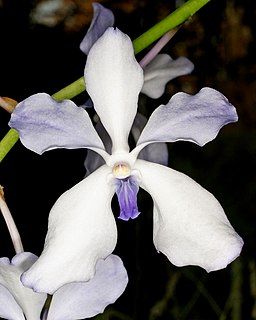
Vanda, abbreviated in the horticultural trade as V., is a genus in the orchid family, Orchidaceae. There are about 87 species, and the genus is commonly cultivated for the marketplace. This genus and its allies are considered to be among the most specifically adapted of all orchids within the Orchidaceae. The genus is highly prized in horticulture for its showy, fragrant, long-lasting, and intensely colorful flowers. Vanda species are widespread across East Asia, Southeast Asia, and New Guinea, with a few species extending into Queensland and some of the islands of the western Pacific.
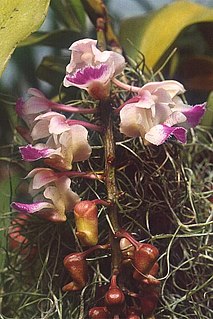
Aerides, known commonly as cat's-tail orchids and fox brush orchids, is a genus belonging to the orchid family. It is a group of tropical epiphyte orchids that grow mainly in the warm lowlands of tropical Asia from India to southern China to New Guinea. They are valued in horticulture for their racemes of showy, fragrant, colorful flowers.

Phalaenopsis, also known as moth orchids, is a genus of about seventy species of plants in the family Orchidaceae. Orchids in this genus are monopodial epiphytes or lithophytes with long, coarse roots, short, leafy stems and long-lasting, flat flowers arranged in a flowering stem that often branches near the end. Orchids in this genus are native to India, Taiwan, China, Southeast Asia, New Guinea and Australia with the majority in Indonesia and the Philippines.

Cymbidium, commonly known as boat orchids, is a genus of evergreen flowering plants in the orchid family Orchidaceae. Orchids in this genus are epiphytic, lithophytic, terrestrial or rarely leafless saprophytic herbs usually with pseudobulbs. There are usually between three and twelve leaves arranged in two ranks on each pseudobulb or shoot and lasting for several years. From one to a large number of flowers are arranged on an unbranched flowering stem arising from the base of the pseudobulb. The sepals and petals are all free from and similar to each other. The labellum is significantly different from the other petals and the sepals and has three lobes. There are about fifty-five species and sixteen further natural hybrids occurring in the wild from tropical and subtropical Asia to Australia. Cymbidiums are well known in horticulture and many cultivars have been developed.
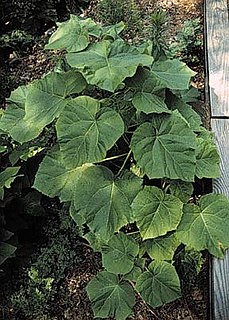
Paulowniaceae are a family of flowering plants within the Lamiales. They are a monophyletic and monogeneric family of trees with currently 7 confirmed species. They were formerly placed within Scrophulariaceae sensu lato, or as a segregate of the Bignoniaceae.
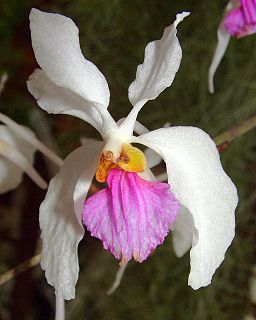
Holcoglossum (Holc.) is a genus of orchids, in the family Orchidaceae. It is native to China and Southeast Asia.
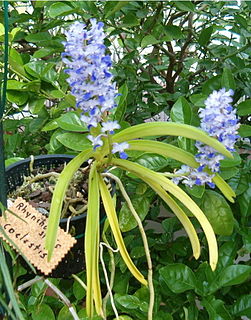
Rhynchostylis is a genus in the orchid family (Orchidaceae), closely allied to the genus Vanda and comprising four currently accepted species native to the Indian Subcontinent, China, Indochina, Malaysia, Indonesia and the Philippines. The name consists of a compound of two Greek elements : rhynchos 'beak' and stylis 'column' – in reference to the very broad, fleshy column of the flower. The flowers are borne in dense racemes and are noted for their intense, spicy fragrance. Although lacking in pseudobulbs, the plants have leathery leaves that are drought-resistant. These orchids grow naturally in warm, moist, shaded tropical areas and will thrive in cultivation if given consistent warmth, uniform moisture and bright, but indirect light. Hobbyists wanting to grow them will need a warm, humid growing environment with gentle air movement. They can be grown in pots, but are better grown in baskets, owing to the extreme fleshiness of their roots. Their unusually fragrant blooms often appear in the slightly cooler winter months.
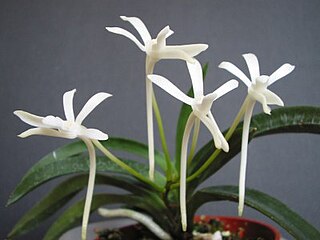
Neofinetia was a genus of flowering plants from the orchid family, Orchidaceae, that is now classified as a Vanda. It contained three species and was distributed in China, Korea, and Japan.

The Vandeae is a large monophyletic tribe within the family of orchids.

Vanda garayi, or Garay's ascocentrum, is a small monopodial epiphytic orchid native to semi-deciduous and deciduous dry lowland forests of Thailand, Laos, and Sumatra.

Vanda xichangensis is a species of epiphytic orchid native to China South-Central. It differs in the spur length from Vanda falcata. Some authors dispute this species status and regard it as a subspecies of Vanda falcata. Dr. Martin Motes argues against effective isolating mechanisms of the length of the spur. Accorting to Motes, the variation of this characteristic easily falls within a species range of variation and further research might reduce it to a varietal status.
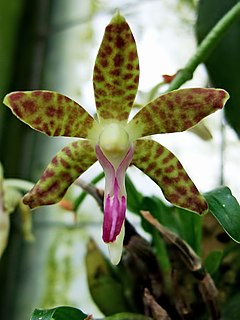
Phalaenopsis subparishii, also known as 短茎萼脊兰 in Chinese, is a species of epiphyte in the family Orchidaceae, endemic to China, occurring in the provinces N Fujian, N Guangdong, NE Guizhou, SW Hubei, Hunan, NE Sichuan and Zhejiang at altitudes of 300–1100 m. The 1 to 1.5 cm long stems bear 1–10 cm long and 2.4-3.3 cm wide, alternate leaves. Inflorescences are between 9 and 10 cm in length and bear flowers with yellowish green, spotted petals and sepals. The spotting is pale brown on the adaxial surface. The midlobe bears lavender spotting. The horn-shaped spur ranges from 0.9 to 1.1 cm in length. The plants have four pollinia in two pairs. The species is closely related to Phalaenopsis tsii, which is however smaller than Phalaenopsis subparishii and it has a larger, white labellum in addition to a longer spur and column.

Phalaenopsis japonica, also known as 萼脊兰 in Chinese, 나도붕난 (nadopungnan) in Korean and ナゴラン or 名護蘭 (nago-ran) in Japanese, is a species of epiphyte in the family Orchidaceae, native to open forests of China, Japan and Korea, occurring at altitudes of 600–1400 m. It also may grow lithophytically on cliffs along valleys. The 1 to 1.5 cm long stems bear 6–13 cm long and 2–3 cm wide, alternate leaves. Inflorescences are between 17 and 19 cm in length and bear flowers with whitish green, petals and sepals. The lateral sepals bear 1-3 transverse bands of dull brown spots on the adaxial surface. The midlobe is spotted purple to red. The horn-shaped spur ranges from 1.2 to 1.4 cm in length. The plants have four pollinia in two pairs, but previously they have been mistaken as two pollinia.
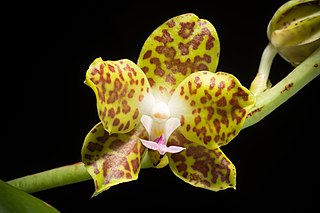
Phalaenopsis hygrochila, also known as 湿唇兰 in Chinese, is a species of epiphytic orchid native to Assam, Borneo, China South-Central, China Southeast, East Himalaya, Laos, Malaya, Myanmar, Bangladesh, Nepal, Sumatera, Thailand, Vietnam and West Himalaya. This species has a complex taxonomic history and has been previously assigned to several genera. The extensive list of synonyms may be explained by this species wide distribution, its early discovery and unusual morphology compared to other species of the genus Phalaenopsis.

Vanda dives is a species of epiphytic orchid native to Vietnam and Laos.

Diploprora truncata is a species of orchid native to East Himalaya and Thailand. Despite its placement within the genus Diploprora, it has been reported to be more closely related to Malleola baliensis, which is a synonym of Robiquetia aberrans (Schltr.) Kocyan & Schuit, than to the type species of the genus Diploprora championii. Thus, the genus is polyphyletic. The epiphytic plants have pendulous, monopodial stems, which bear distichously arranged, lanceolate leaves, which form sheaths around the stem. The widely spreading flowers are produced on lateral, laxly several flowered inflorescences.
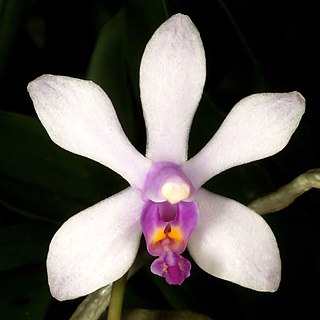
Phalaenopsis wilsonii, also known as 华西蝴蝶兰 in Chinese, is a species of epiphyte in the family Orchidaceae, native to China, Tibet, Myanmar and Vietnam. Additionally it has been recorded in India.
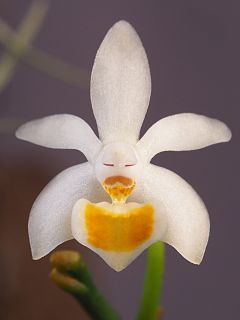
Phalaenopsis malipoensis, also known as 麻栗坡蝴蝶兰 in Chinese, is a species of orchid native to South-Central China and Vietnam. The specific epithet malipoensis refers to the Chinese locality Malipo, which is a hotspot for biodiversity research in Yunnan Province, China.
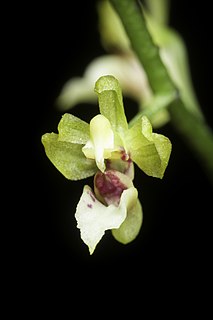
Phalaenopsis mirabilis is a species of orchid native to Vietnam and Thailand. The specific epithet mirabilis means wonderful, marvellous or extraordinary.
